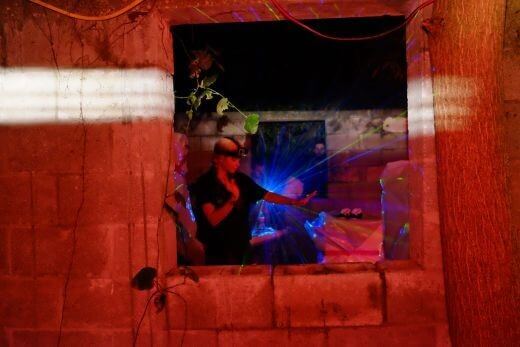- Deborah Kass, Double Yentl (My Elvis) Global Positioning Systems

- No Neutral Spaces: Material Art Fair 2015
Tara Elizabeth Long: Røle Mødel
Monica Uszerowicz

Tara Elizabeth Long. Photo: Sarah MK Moody
It is a hallmark of grandly chaotic spectacles to be quietly defined by tight parameters, which, though seemingly antithetical to the outcome, actually contribute to the madness of it all. The best example of this might be rules that evolve in children’s playground games: this pole is home base, you can’t run past a building of this color, if you barely brush the chased party, he or she isn’t “it” anymore. Given distinct restrictions to pivot from, a restrained frenzy can feel more potent than its uncontained counterpart.
It was within a very particular framework that Tara Elizabeth Long presented Røle Mødel, a performance and installation that may or may not have been intended as a shared experience. (That part matters little.) With a GoPro camera strapped to her head, Long danced for three self-allotted hours in a roofless and mostly wall-less stone structure—a mysterious amenity in the backyard of Guccivuitton gallery co-founder Domingo Castillo, the almost-building has preceded Røle Mødel as a setting for shows and house parties. There were two DJ sets: the first by Andrew Byrd, a.k.a. Byrdipop, the second by Long’s aunt Annette Polizzano, moonlighting as Allapattah Chatta, spinning remixes of Frank Sinatra and Madonna (and killing it, in earnest). Plastic-swathed furniture (maybe a lamp and maybe a chair) dotting the space ultimately felt dystopian. Lit by blue-green laser beams and sometimes smiling, Long often closed her eyes as viewers watched her through the square openings that once housed windows or—if brave or drunk or chill enough—chose to participate and dance alongside her. But she, too, was watching us all the while; the ultimate destination and precise purpose of the GoPro footage is a mystery.
Long, who has worked on large-scale creative projects in both the art community and the entertainment industry, seems interested in an invisible Venn diagram between the two, and, in particular, the way the cultures both inform and mock each other (the event flyer featured an inevitable connection to Miami booty bass). As she danced, all revealed became ever-present, extending energetically beyond the installation itself: we are aware of her self-imposed limitations and her ability to mold and move through them; we know that Allapattah Chattah and Byrdipop may be extensions of her own self; we realize, eventually, that she is a little imprisoned, that her jail is a warm one, and that she may not even know we are visiting. It is not immediately clear, though, if she is entertaining us or creating a “space.”
In a blur of potential contexts, there is an inherent overlap among all given possibilities. The DJ booth was set up as it would be at any other nightclub; the accompanying laser lights, too. The furniture’s plastic covering seemed aesthetically intentional, but may have only served as protection from the rain—which is to say, the space really did look like a lounge. Derek Villanueva was the event’s bouncer (or “bouncer”), a representation of and stand-in for Long’s other life and career. Allapattah Chatta’s set was loud enough to hear from the street, which is residential, and neighbors assumed it was just another
party.
Only when the vibe reverberated outward, beyond the lights and beyond the characters, did the aspect of play became a visible thing: this was less party than pretend party, less exhibition than pretend exhibition, and ecstatically both of these things in reality—as valid as other examples of the latter and better than most other incarnations of the former. If the apocalypse occurs, Miami is the first to sink; Miamians must have a constant, cellular awareness of their imminent doom. In Røle Mødel, buildings have already been gutted and overtaken by flora and only a few survivors are left at the club, frozen mid-motion.
Through her dance, Long had (perhaps unwittingly) created an interdimensional portal into a future in which she could self-actualize, becoming the artist in real time. Spectators were not asked to become participants, but were rather compelled; there was no initial shared dialogue, but Long was indeed watching her viewers. Røle Mødel, then, had first the effect of staring at an especially dynamic painting—carefully contrived composition and all—and then the feeling of a freaky be-in at the end of the world, the greatest time of all to close your eyes and bathe in weird neon.









